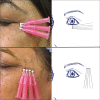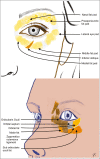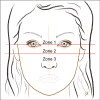Periorbital Rejuvenation: A Study on the Use of Dermal Threads as Monotherapy, with a Review of Literature
- PMID: 35655650
- PMCID: PMC9153308
- DOI: 10.4103/JCAS.JCAS_221_20
Periorbital Rejuvenation: A Study on the Use of Dermal Threads as Monotherapy, with a Review of Literature
Abstract
The periorbital region, a major impressionable area holds a special place in aging of the face. It reflects chronological aging which are reflected not only as structural changes but also emotive expressions of sadness and tiredness. Dermal threads have been used in combination with other aesthetic procedures, however their use as monotherapy especially in periorbital region needs evaluation.
Aim: To evaluate the improvement in wrinkling and skin texture in the infero-lateral periorbital region with monofilament dermal threads.
Settings and design: A prospective observational study in a tertiary hospital was conducted between January 2019 and February 2020 after institutional ethical clearance and patient consent.
Materials and methods: 25 adults between 40 and 65 years of age reporting for infero-lateral periorbital rejuvenation and opting for dermal threads, with no history of aesthetic treatment in this region for the past three months were included after their informed consent. 10 monofilament dermal threads (5 each in lateral and infraorbital) in either periorbital region were inserted. Cases were assessed with Lemperle's wrinkle scale and visual analog scale (VAS) and photographic record maintained before procedure and after 16 weeks of procedure. Change in wrinkle grade was analysed using paired t-test and VAS was used to assess patient's perception of the result.
Results: 25 cases were included in the study, 21 completed the follow-up and 4 were lost to follow up. The mean preprocedure wrinkle score was 2.29 and postprocedure mean scores were 1. This finding was statistically significant. 16 cases were satisfied with their textural improvement (VAS >+2) while 4 reported mild improvement (VAS 2+) and 1 reported no improvement. Side effects observed were bruising in two cases and thread displacement in one case within 24 hours.
Conclusions: Polydioxanone monothreads offer an alternative aesthetic procedure for periorbital rejuvenation.
Keywords: Periorbital rejuvenation; periorbital wrinkles; polydioxanone thread.
Copyright: © 2022 Journal of Cutaneous and Aesthetic Surgery.
Conflict of interest statement
There are no conflicts of interest.
Figures









Similar articles
-
Novel technique for infraorbital groove correction using multiple twisted polydioxanone thread.J Cosmet Dermatol. 2020 Aug;19(8):1928-1935. doi: 10.1111/jocd.13269. Epub 2020 Jan 3. J Cosmet Dermatol. 2020. PMID: 31900989
-
Combined press cog type and cog PDO threads in comparison with the cog PDO threads in facial rejuvenation.J Cosmet Dermatol. 2021 Oct;20(10):3294-3298. doi: 10.1111/jocd.14092. Epub 2021 May 10. J Cosmet Dermatol. 2021. PMID: 33904637
-
Efficacy study of the new polycaprolactone thread compared with other commercialized threads in a murine model.J Cosmet Dermatol. 2021 Sep;20(9):2743-2749. doi: 10.1111/jocd.13883. Epub 2021 Jan 9. J Cosmet Dermatol. 2021. PMID: 33421303 Free PMC article.
-
Nonsurgical Light and Energy-Based Devices: Utility in Eyelid and Periorbital Surgery.Facial Plast Surg Clin North Am. 2021 May;29(2):323-334. doi: 10.1016/j.fsc.2021.01.007. Epub 2021 Apr 24. Facial Plast Surg Clin North Am. 2021. PMID: 33906764 Review.
-
Periorbital Filling With The MD Codes™ Algorithm: A Narrative Review and a Practical Guide.J Cosmet Dermatol. 2021 Nov;20(11):3398-3406. doi: 10.1111/jocd.14491. Epub 2021 Oct 7. J Cosmet Dermatol. 2021. PMID: 34623020 Review.
Cited by
-
In Vitro Evaluation and Clinical Effects of a Regenerative Complex with Non-Cross-Linked Hyaluronic Acid and a High-Molecular-Weight Polynucleotide for Periorbital Treatment.Polymers (Basel). 2025 Feb 27;17(5):638. doi: 10.3390/polym17050638. Polymers (Basel). 2025. PMID: 40076130 Free PMC article.
References
-
- Robertsiii TT, Yokoo K. Continuing medical education examination—facial aesthetic surgery in pursuit of optimal periorbital rejuvenation: Laser resurfacing with or without blepharoplasty and brow lift. Aesthet Surg J. 1998;18:321–32. - PubMed
-
- Lemperle G, Holmes RE, Cohen SR, Lemperle SM. A classification of facial wrinkles. Plast Reconstr Surg. 2001;108:1735–50; discussion 1751-2. - PubMed
-
- Tamura BM, Odo MY. Classification of periorbital wrinkles and treat- ment with Botulinum Toxin Type A. Surg Cosmet Dermato. 2011;3:129–34.
-
- Love LP, Farrior EH. Periocular Anatomy and Aging. Facial Plast Surg Clin N Am. 2010;18:411–7. - PubMed
LinkOut - more resources
Full Text Sources
Miscellaneous
